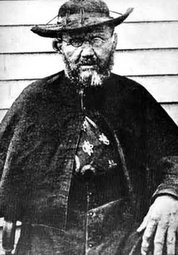
Father Damien
(1) Molokai. The islands name was pronounced bitterly, with loathing and fear. Between 1866 and 1873, nearly eight hundred lepers were quarantined there on an isolated peninsula. Towering volcanic cliffs hemmed them in on three sides, and crashing surf on the fourth. It was a prison, a netherworld made all the more surreal by its pacific beauty.
(2) Abandoned without law or hope, the lepers gave themselves alternately to despair and to what pleasures they could grasp. Robbery and drunkenness, sexual orgies and anarchy marked their lives. When finally, after a torturous descent, the lepers finally succumbed to their disease, their already-decayed bodies often became food for pigs and wild dogs.
(3) Father Damien first came to Hawaii in 1864. He had been born in Europe, the sturdily built son of a well-to-do Belgian farmer. When his brother fell ill and could not travel to his post at Hawaiis Sacred Heart Mission, Damien asked to take his place.
(4) For a decade, Damien served at the mission. During that time, many of his parishioners were forced away to Molokai. Their memory remained wedged in his mind, slowly building into a fearsome emotion. He yearned to go to the lepers and to convey love to them where they lived. In April of 1873, Father Damien wrote to his superiors, asking for permission. A month later, he stood on the beaches of the dreaded isle.
(5) Damien steeled himself for the worst, but the sights and smells of Molokai left him gasping. One of his first encounters was with a young girl, her body already half eaten by worms. One by one, Damien set out to meet them all. Carefully avoiding physical contact, he confronted their rotting bodies, putrid breath, and the ever-present rasped coughing.
(6) Damiens first desire was to remind the lepers of their inherent dignity as children of God. To demonstrate the value of their lives, he honored their deathsconstructing coffins, digging graves, protecting the cemetery from scavenging animals, and ensuring a ceremony for every passing.
(7) As the days went by, however, Damien began to feel that he could not fully convey all that he wished to share without drawing ever nearer. He began timidly to touch the lepers. He ate with them, and hugged them. Over time, he even began to clean and wrap their oozing sores. Everything Damien did, he did with the lepers. Together, they built coffins and chapels, cottages and roads. He taught them how to farm, raise animals, and even sing despite their mangled vocal chords. One report described him teaching two lepers to play the organ with the ten fingers they still had between them.
(8) Damien sought to draw near to the lepers in his words as well, even speaking of we lepers. Writing to his brother in Europe, he explained, I make myself a leper with the lepers to gain all to Jesus Christ. That is why, in preaching, I say we lepers; not my brethren
(9) It was eleven years after Damiens arrival on Molokai that he spilled boiling water on his leg. He watched in horror as his feet blisteredyet felt no pain. His efforts to draw ever nearer to the lepers were complete. Now he would meet them in their disease as well.
(10) The final five years of his life, Damien served the lepers of Molokai as a leper priest. The days passed with both joy and suffering. Outpourings of international support arrived at the island, and also several helpers. Alongside the blessings, however, came physical pain, and times of loneliness and even depression. Finally, on April 15, 1889, Damien breathed his last. He was laid to rest among the thousands of lepers he had helped to bury in what he called his garden of the dead.
(11) In 1936, at the request of the Belgian government, Father Damiens body was returned to his birthplace. Years later, the people of Molokai pleaded that at least part of their beloved Father be returned to them. What they finally received, with joy, was Damiens right handthe hand that had touched and soothed and embraced them, even when everyone else had done all they could to keep the lepers far away.
(1) Molokai. The islands name was pronounced bitterly, with loathing and fear. Between 1866 and 1873, nearly eight hundred lepers were quarantined there on an isolated peninsula. Towering volcanic cliffs hemmed them in on three sides, and crashing surf on the fourth. It was a prison, a netherworld made all the more surreal by its pacific beauty.
(2) Abandoned without law or hope, the lepers gave themselves alternately to despair and to what pleasures they could grasp. Robbery and drunkenness, sexual orgies and anarchy marked their lives. When finally, after a torturous descent, the lepers finally succumbed to their disease, their already-decayed bodies often became food for pigs and wild dogs.
(3) Father Damien first came to Hawaii in 1864. He had been born in Europe, the sturdily built son of a well-to-do Belgian farmer. When his brother fell ill and could not travel to his post at Hawaiis Sacred Heart Mission, Damien asked to take his place.
(4) For a decade, Damien served at the mission. During that time, many of his parishioners were forced away to Molokai. Their memory remained wedged in his mind, slowly building into a fearsome emotion. He yearned to go to the lepers and to convey love to them where they lived. In April of 1873, Father Damien wrote to his superiors, asking for permission. A month later, he stood on the beaches of the dreaded isle.
(5) Damien steeled himself for the worst, but the sights and smells of Molokai left him gasping. One of his first encounters was with a young girl, her body already half eaten by worms. One by one, Damien set out to meet them all. Carefully avoiding physical contact, he confronted their rotting bodies, putrid breath, and the ever-present rasped coughing.
(6) Damiens first desire was to remind the lepers of their inherent dignity as children of God. To demonstrate the value of their lives, he honored their deathsconstructing coffins, digging graves, protecting the cemetery from scavenging animals, and ensuring a ceremony for every passing.
(7) As the days went by, however, Damien began to feel that he could not fully convey all that he wished to share without drawing ever nearer. He began timidly to touch the lepers. He ate with them, and hugged them. Over time, he even began to clean and wrap their oozing sores. Everything Damien did, he did with the lepers. Together, they built coffins and chapels, cottages and roads. He taught them how to farm, raise animals, and even sing despite their mangled vocal chords. One report described him teaching two lepers to play the organ with the ten fingers they still had between them.
(8) Damien sought to draw near to the lepers in his words as well, even speaking of we lepers. Writing to his brother in Europe, he explained, I make myself a leper with the lepers to gain all to Jesus Christ. That is why, in preaching, I say we lepers; not my brethren
(9) It was eleven years after Damiens arrival on Molokai that he spilled boiling water on his leg. He watched in horror as his feet blisteredyet felt no pain. His efforts to draw ever nearer to the lepers were complete. Now he would meet them in their disease as well.
(10) The final five years of his life, Damien served the lepers of Molokai as a leper priest. The days passed with both joy and suffering. Outpourings of international support arrived at the island, and also several helpers. Alongside the blessings, however, came physical pain, and times of loneliness and even depression. Finally, on April 15, 1889, Damien breathed his last. He was laid to rest among the thousands of lepers he had helped to bury in what he called his garden of the dead.
(11) In 1936, at the request of the Belgian government, Father Damiens body was returned to his birthplace. Years later, the people of Molokai pleaded that at least part of their beloved Father be returned to them. What they finally received, with joy, was Damiens right handthe hand that had touched and soothed and embraced them, even when everyone else had done all they could to keep the lepers far away.
Reflection...
What is the first thing that Damien had to do (paragraph 4)?
What is the first thing that Damien had to do (paragraph 4)?
What drove him to show compassion to the lepers (6)?
How did he change their standard of living (7)?
Reread paragraph (8). What is the significance of this?
Describe how Damiens compassion for the lepers was similar to Jesus compassion for all sinners? How are their life stories the same?
Describe how Damiens compassion for the lepers was similar to Jesus compassion for all sinners? How are their life stories the same?
God calls us to show the same compassion. Read Colossians 3:12-14.
And so, as those who have been chosen of God,
holy and beloved, put on a heart of compassion,
kindness, humility, gentleness and patience;
bearing with one another, and forgiving each other,
whoever has a complaint against anyone;
just as the Lord
forgave you, so also should you.
And beyond all these things [put on] love,
which is the perfect bond of unity.
(Colossians 3:12-14 NASB)
Application Questions:
Why are we called to be compassionate?
Who around you can you show compassion to?
What are some practical ways you can show compassion?
What will be the risks that you will face?
What are the rewards?
Application Exercise: (Choose one or both of the following exercises)
1. As a family (small group), come up with a compassion project that you can all do together. Examples: soup kitchen, donating clothes, helping out a family in need, visit someone from church currently living at a nursing home, give out food or clothing (socks) downtown, etc.
2. Have each person in the family (small group) pick one person or group of people that they want to show compassion to, and how they plan to do it. Challenge them to do so for a week, and follow up with them the next week (at small group session).
1. As a family (small group), come up with a compassion project that you can all do together. Examples: soup kitchen, donating clothes, helping out a family in need, visit someone from church currently living at a nursing home, give out food or clothing (socks) downtown, etc.
2. Have each person in the family (small group) pick one person or group of people that they want to show compassion to, and how they plan to do it. Challenge them to do so for a week, and follow up with them the next week (at small group session).

No comments:
Post a Comment